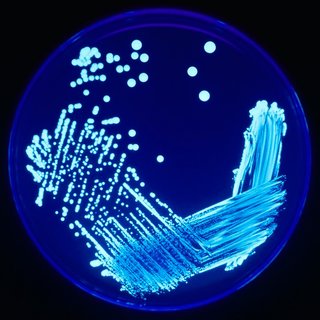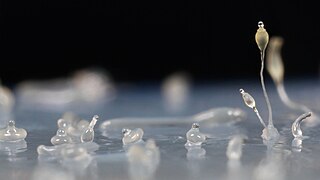Related Research Articles

The Percolozoa are a group of colourless, non-photosynthetic Excavata, including many that can transform between amoeboid, flagellate, and cyst stages.

Legionella is a genus of pathogenic gram-negative bacteria that includes the species L. pneumophila, causing legionellosis including a pneumonia-type illness called Legionnaires' disease and a mild flu-like illness called Pontiac fever.

The dictyostelids or cellular slime molds are a group of slime molds or social amoebae.

Acanthamoeba is a genus of amoebae that are commonly recovered from soil, fresh water, and other habitats. The genus Acanthamoeba has two stages in its life cycle, the metabolically active trophozoite stage and a dormant, stress-resistant cyst stage. In nature, Acanthamoeba species are generally free-living bacterivores. However, they are also opportunistic pathogens able to cause serious and sometimes fatal infections in humans and other animals.
Free-living amoebae are a group of protozoa that are important causes of infectious disease in humans and animals.

Naegleriasis, also known as primary amoebic meningoencephalitis (PAM), is an almost invariably fatal infection of the brain by the free-living unicellular eukaryote Naegleria fowleri. Symptoms are meningitis-like and include headache, fever, nausea, vomiting, a stiff neck, confusion, hallucinations and seizures. Symptoms progress rapidly over around five days, and death usually results within one to two weeks of symptoms.

Naegleria is a free living amoebae protist genus consisting of 47 described species often found in warm aquatic environments as well as soil habitats worldwide. It has three life cycle forms: the amoeboid stage, the cyst stage, and the flagellated stage, and has been routinely studied for its ease in change from amoeboid to flagellated stages. The Naegleria genera became famous when Naegleria fowleri, a human pathogenic strain and the causative agent of primary amoebic meningoencephalitis (PAM), was discovered in 1965. Most species in the genus, however, are nonpathogenic, meaning they do not cause disease.

Legionella pneumophila is an aerobic, pleomorphic, flagellated, non-spore-forming, Gram-negative bacterium of the genus Legionella. L. pneumophila is the primary human pathogen in the genus Legionella. In nature, L. pneumophila infects soil amoebae of the genus Acanthamoeba and freshwater amoeboflagellates of the genus Naegleria. This pathogen is thus found commonly near freshwater environments and invades the unicellular life found in these environments, using them to carry out metabolic functions.

Amoeba proteus is a large species of amoeba closely related to another genus of giant amoebae, Chaos. As such, the species is sometimes given the alternative scientific name Chaos diffluens.

Amoeba is a genus of single-celled amoeboids in the family Amoebidae. The type species of the genus is Amoeba proteus, a common freshwater organism, widely studied in classrooms and laboratories.

Naegleria gruberi is a species of Naegleria. It is famous for its ability to change from an amoeba, which lacks a cytoplasmic microtubule cytoskeleton, to a flagellate, which has an elaborate microtubule cytoskeleton, including flagella. This "transformation" includes de novo synthesis of basal bodies.

Mastigamoeba is a genus of pelobionts, and treated by some as members of the Archamoebae group of protists. Mastigamoeba are characterized as anaerobic, amitochondriate organisms that are polymorphic. Their dominant life cycle stage is as an amoeboid flagellate. Species are typically free living, though endobiotic species have been described.
Psalteriomonas is a genus of excavates in the group of Heterolobosea. The genus was first discovered and named in 1990. It contains amoeboflagellate cells that live in freshwater anaerobic sediments all over the world. The microtubule-organizing ribbon and the associated microfibrillar bundles of the mastigote system is the predominant feature in Psalteriomonas. This harp-shaped complex gives rise to the name of this genus. Psalteriomonasforms an endosymbiotic relationship with methanogenic bacteria, especially with Methanobacterium formicicum There are currently three species in this genus: P. lanterna, P. vulgaris, and P. magna.

The vampyrellids, colloquially known as vampire amoebae, are a group of free-living predatory amoebae classified as part of the lineage Endomyxa. They are distinguished from other groups of amoebae by their irregular cell shape with propensity to fuse and split like plasmodial organisms, and their life cycle with a digestive cyst stage that digests the gathered food. They appear worldwide in marine, brackish, freshwater and soil habitats. They are important predators of an enormous variety of microscopic organisms, from algae to fungi and animals. They are also known as aconchulinid amoebae.
Legionella anisa is a Gram-negative bacterium, one of more than 40 species in the family Legionellaceae. After Legionella pneumophila, this species has been isolated most frequently from water samples. This species is also one of the several pathogenic forms of Legionella having been associated with rare clinical cases of illness including Pontiac fever and Legionnaires' disease.
Legionella cherrii is an aerobic, flagellated, Gram-negative bacterium from the genus Legionella. It was isolated from a heated water sample in Minnesota. L. cherrii is similar to another Legionella species, L. pneumophila, and is believed to cause major respiratory problems.

An amoeba, often called an amoeboid, is a type of cell or unicellular organism with the ability to alter its shape, primarily by extending and retracting pseudopods. Amoebae do not form a single taxonomic group; instead, they are found in every major lineage of eukaryotic organisms. Amoeboid cells occur not only among the protozoa, but also in fungi, algae, and animals.

Naegleria fowleri, also known as the brain-eating amoeba, is a species of the genus Naegleria. It belongs to the phylum Percolozoa and is technically classified as an amoeboflagellate excavate, rather than a true amoeba. This free-living microorganism primarily feeds on bacteria but can become pathogenic in humans, causing an extremely rare, sudden, severe, and usually fatal brain infection known as naegleriasis or primary amoebic meningoencephalitis (PAM).
Legionella clemsonensis was isolated in 2006, but was described in 2016 by Clemson University researchers. It is a Gram-negative bacterium.

Amoebozoa of the free living genus Acanthamoeba and the social amoeba genus Dictyostelium are single celled eukaryotic organisms that feed on bacteria, fungi, and algae through phagocytosis, with digestion occurring in phagolysosomes. Amoebozoa are present in most terrestrial ecosystems including soil and freshwater. Amoebozoa contain a vast array of symbionts that range from transient to permanent infections, confer a range of effects from mutualistic to pathogenic, and can act as environmental reservoirs for animal pathogenic bacteria. As single celled phagocytic organisms, amoebas simulate the function and environment of immune cells like macrophages, and as such their interactions with bacteria and other microbes are of great importance in understanding functions of the human immune system, as well as understanding how microbiomes can originate in eukaryotic organisms.
References
- 1 2 3 4 5 6 7 8 9 10 11 12 13 14 15 16 17 18 19 De Jonckheere JF, Dive DG, Pussard M, Vickerman K (1984). "Willaertia magna gen. nov., sp. Nov. (Vahlkampfiidae). A thermophilic amoeba found in different habitats". Protistologica. 20 (1): 5–13.
- 1 2 3 4 5 6 7 8 9 10 11 12 13 Robinson BS, Christy PE, De Jonckheere JF (January 1989). "A temporary flagellate (mastigote) stage in the vahlkampfiid amoeba Willaertia magna and its possible evolutionary significance". Bio Systems. 23 (1): 75–86. doi:10.1016/0303-2647(89)90010-5. PMID 2624890.
- 1 2 3 4 5 6 7 Hasni I, Jarry A, Quelard B, Carlino A, Eberst JB, Abbe O, Demanèche S (February 2020). "Willaertia magna C2c Maky". Pathogens. 9 (2): 105. doi: 10.3390/pathogens9020105 . PMC 7168187 . PMID 32041369.
- 1 2 3 Michel R, Raether W (November 1985). "Protonaegleria westphali gen. nov., sp. nov.(Vahlkampfiidae) a thermophilic amoebo-flagellate isolated from freshwater habitat in India". Zeitschrift für Parasitenkunde. 71 (6): 705–13. doi:10.1007/BF00926796. S2CID 44723205.
- 1 2 Brown S, De Jonckheere JF (February 1999). "A reevaluation of the amoeba genus Vahlkampfia based on SSUrDNA sequences". European Journal of Protistology. 35 (1): 49–54. doi:10.1016/S0932-4739(99)80021-2.
- 1 2 Niyyati M, Lorenzo-Morales J, Haghi AM, Valladares B (2009). "Isolation of Vahlkampfiids (Willaertia magna) and Thecamoeba from soil samples in Iran". Iranian Journal of Parasitology. 4 (1): 48–52.
- ↑ Hasni, Issam; Chelkha, Nisrine; Baptiste, Emeline; Mameri, Mouh Rayane; Lachuer, Joel; Plasson, Fabrice; Colson, Philippe; La Scola, Bernard (2019-12-04). "Investigation of potential pathogenicity of Willaertia magna by investigating the transfer of bacteria pathogenicity genes into its genome". Scientific Reports. 9 (1): 18318. doi: 10.1038/s41598-019-54580-6 . ISSN 2045-2322. PMC 6892926 . PMID 31797948.
- ↑ De Jonckheere JF, Brown S (March 1995). "Willaertia minor is a species of Naegleria". European Journal of Protistology. 31 (1): 58–62. doi:10.1016/S0932-4739(11)80357-3.
- 1 2 3 4 5 Hasni I, Chelkha N, Baptiste E, Mameri MR, Lachuer J, Plasson F, et al. (December 2019). "Investigation of potential pathogenicity of Willaertia magna by investigating the transfer of bacteria pathogenicity genes into its genome". Scientific Reports. 9 (1): 18318. Bibcode:2019NatSR...918318H. doi:10.1038/s41598-019-54580-6. PMC 6892926 . PMID 31797948.
- ↑ De Jonckheere JF (January 1989). "Variation of electrophoretic karyotypes among Naegleria spp". Parasitology Research. 76 (1): 55–62. doi:10.1007/BF00931073. PMID 2622896. S2CID 22632942.